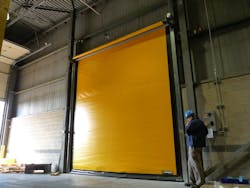2015 IECC Code recognizes benefits of high-speed doors
The 2015 edition of the International Energy Conservation Code (IECC) will recognize high-speed doors and their energy-efficiency benefits for the first time.
The 2015 code defines a high-speed door and includes a maximum air leakage requirement through doors. The new high-speed door maximum air leakage requirement is 1.3 cubic feet per minute per square foot (cfm/sf). This is higher than the maximum sectional garage door requirement of 0.4 cfm/sf.
High-speed doors have a higher value because they must be flexible at the jambs to allow for both the speed and amount of movement during the life of the door. “The predominant benefit of high-speed doors is their ability to control ‘air exchange’ or the air flowing through a door opening when a door is not fully closed,” according to Jeff Wendt of Rytec Corporation.
When taking thermal transmittance (U-factor), air leakage, and door power usage into consideration, "air exchange" is the most significant part of the total energy loss for a door. High-speed doors are typically specified for applications requiring 75 to 100 cycles per day. Thus, these doors demonstrate superior overall energy efficiency when meeting demand for high-cycle operation in a building.
For more information, visit here.
